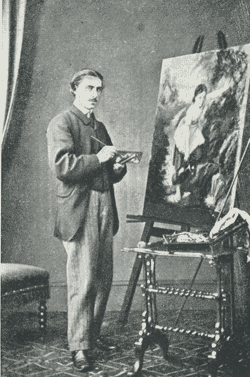Paul Mary Gray, Book Illustrator
(b. 1842, d. 1866)
Book Illustrator
From A Dictionary of Irish Artists 1913

Paul Mary Gray. Photograph.
Was born in Dublin on the 17th May, 1842, the son of William Godfrey Gray, who for many years had a musical academy at No. 32 Camden Street and afterwards at No. 10 Lennox Street. He was educated at the Jesuits' School at Tullabeg, and on leaving he was for a short time in the Dominican Novitiate at Woodchester. But finding that he had no vocation for the life of a religious order he returned to Dublin. From his childhood he had shown marked talents for drawing and music and now determined to become an artist. For a time he was drawing master at Tullabeg School, and also found employment with Dillon the print-seller in Stephen's Green. In 1861, 1862 and 1863 he exhibited a number of pictures, domestic scenes and figure subjects, in the Royal Hibernian Academy. Of these "The Sick Artist," shown in 1861, now belongs to Miss Magrath, 41 Synge Street, and "In the Cornlands" was purchased by the Art Union of Ireland as a prize for its subscribers. In 1863, at the age of 21, he went to London by the advice of his friends, John and Michael Gunn, who furnished him with letters to Tom Hood, Arthur Sketchley and others. Both Hood and Sketchley became his friends, and he attracted everybody by his gentleness and indescribable charm of manner. By taste and inclination he was a painter, but he was obliged by the necessities of his position to become a draughtsman on wood. Hood was the first to appreciate his talent, and introduced him to the magazine publishers.
His earliest published drawing was the frontispiece to "The Bunch of Keys." His twelve illustrations to Kingsiey's "Hereward" in "Good Words" for 1865 made him known, and his services as an illustrator were requisitioned for "Once a Week," "London Society," "The Sunday Magazine," "The Quiver," "The Argosy" and "The Broadway," where some of his best work, full of imagination and humour, and charming in conception and in drawing, will be found. In the "Shilling Magazine" in 1855-6 appeared thirteen illustrations for Miss M. Betham-Edwards' "The White Rose of Ravensworth." "The Noon of Love," a large full-page engraving by him, is in Tom Hood's "Round of Days," 1866. For some time he did the large cartoons in the new series of "Fun," in which the versatility and vigour of his talent is best shown; and some of these, such as "Gone from the Helm " and "Beyond all Hope" were republished in a separate form. He also contributed drawings to "Punch," and was about to be placed on the regular staff of the paper at the time of his death.
Fame and fortune seemed fairly within his reach when his health, never strong, gave way under the incessant strain of his work, and he was obliged to seek a change and rest at Brighton. There he died, in his lodgings, 35 Montpelier Street, on the 14th November, 1866, aged 24, closing by an early death a career that promised to be brilliant. He was keenly regretted by his friends and fellow-artists, who erected a cross over his grave in Kensal Green Cemetery. His last drawing, "Sweet-hearting," which he lived just long enough to finish, was published in the "Savage-Club Papers." Gray had supported his widowed mother, and after his death Hood, Sketchley and others of his friends gave a performance in the Haymarket theatre of a play written and acted by themselves, which produced a considerable sum for her benefit.
